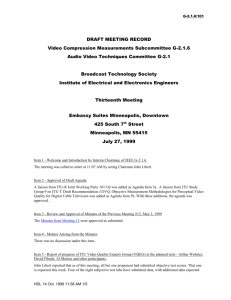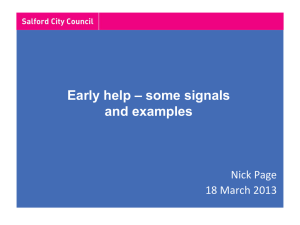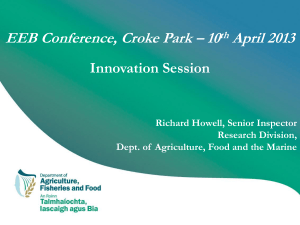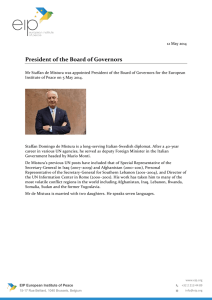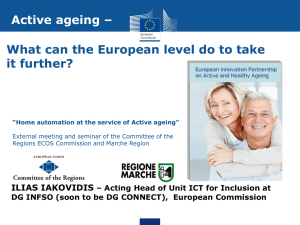216m17mr - IEEE Standards Working Group Areas
advertisement
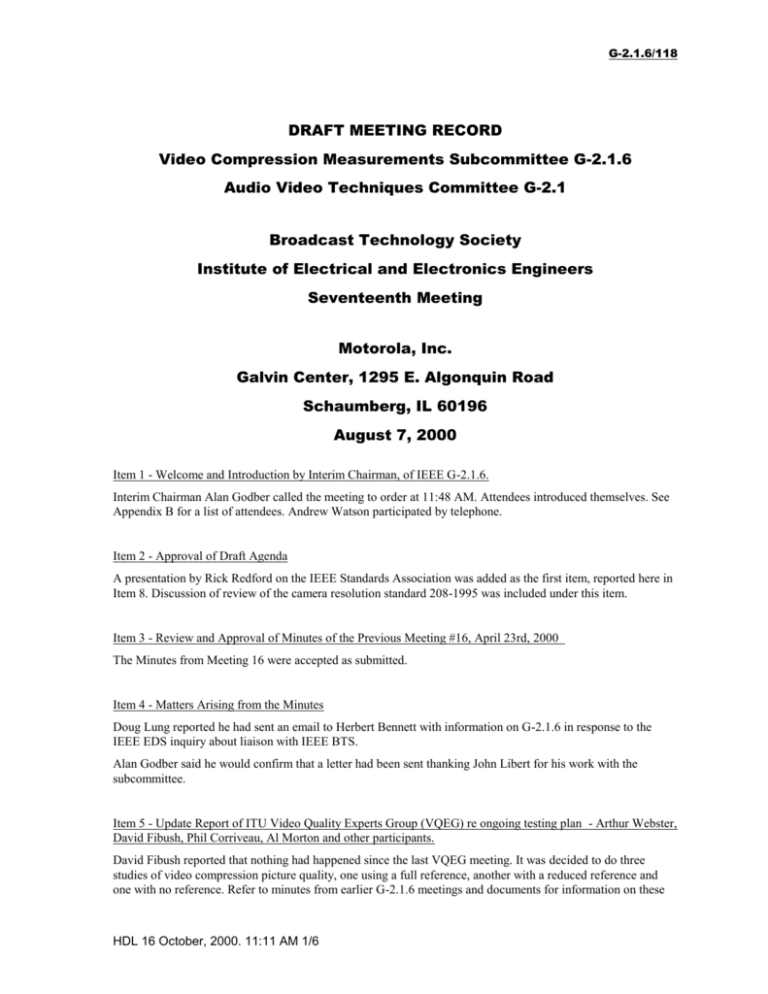
G-2.1.6/118 DRAFT MEETING RECORD Video Compression Measurements Subcommittee G-2.1.6 Audio Video Techniques Committee G-2.1 Broadcast Technology Society Institute of Electrical and Electronics Engineers Seventeenth Meeting Motorola, Inc. Galvin Center, 1295 E. Algonquin Road Schaumberg, IL 60196 August 7, 2000 Item 1 - Welcome and Introduction by Interim Chairman, of IEEE G-2.1.6. Interim Chairman Alan Godber called the meeting to order at 11:48 AM. Attendees introduced themselves. See Appendix B for a list of attendees. Andrew Watson participated by telephone. Item 2 - Approval of Draft Agenda A presentation by Rick Redford on the IEEE Standards Association was added as the first item, reported here in Item 8. Discussion of review of the camera resolution standard 208-1995 was included under this item. Item 3 - Review and Approval of Minutes of the Previous Meeting #16, April 23rd, 2000 The Minutes from Meeting 16 were accepted as submitted. Item 4 - Matters Arising from the Minutes Doug Lung reported he had sent an email to Herbert Bennett with information on G-2.1.6 in response to the IEEE EDS inquiry about liaison with IEEE BTS. Alan Godber said he would confirm that a letter had been sent thanking John Libert for his work with the subcommittee. Item 5 - Update Report of ITU Video Quality Experts Group (VQEG) re ongoing testing plan - Arthur Webster, David Fibush, Phil Corriveau, Al Morton and other participants. David Fibush reported that nothing had happened since the last VQEG meeting. It was decided to do three studies of video compression picture quality, one using a full reference, another with a reduced reference and one with no reference. Refer to minutes from earlier G-2.1.6 meetings and documents for information on these HDL 16 October, 2000. 11:11 AM 1/6 G-2.1.6/118 three methods. There has been very little response on the full reference TV study. Based on the low level of activity, it appears VQEG is dead. Resources are a problem – both subjective labs and proponents needed to put many resources into the effort. It was reported that ITU working party 10/11Q is now working party 6Q. Although a meeting was scheduled for September, the chairman had decided to postpone the meeting. An intermediate meeting of ITU Study Group 9 will be held in November at Tektronix. Study Group 9 intends to provide a draft recommendation that includes objective methods from some of the proponents, probably two or three different methods. Possible criteria to be in the recommendation include full disclosure of the methodology and demonstration of improved results over and above what VQEG showed. This would not be verified by a third party. With the recommendation of two or three different methods, Dr. Watson’s work will become more important. It was also noted that ITU-T Study Group 12 has written its question to take the group out of full reference TV compression measurements to focus on two-way video conferencing – “conversational multimedia”. 5.1 Further Discussion and Recommendations from the Subcommittee to the next meeting of VQEG There was a comment that when this group was started two or three years ago, we had to support VQEG. Now that the VQEG effort appears to be faltering, we need to consider emphasizing our own efforts to develop a standard. There was a question about work on improving current algorithms. The response was that this was the major work of the full reference TV group. However, when a revamped objective test plan was presented for comments, there was no response. There was also concern about how it would be possible to recommend three methods based on the old algorithms, given the wide range of results in the VQEG tests when compared with what is possible using analog measurements. Study Group 9 should be clear about the limited resolving power of these measurement methodologies in its recommendation. Item 6 - Selecting Test Method, Test Material and Test Labs for a Unit of Measure (JND) & a Means of Calibration for Video Impairment, Chair, Leon Stanger. Andrew Watson presented his Preliminary Report on JND Measurement, IEEE Doc. G-2.1.6/116, August 7, 2000 and his Proposal on JND Measurement, IEEE Doc. G-2.1.6/117, August 7, 2000. Both documents are available at http://vision.arc.nasa.gov/jnd/. The purpose of this experiment was to measure JND scales for the sequences used in the VQEG tests. The results show that these scales may give results more reliable than those obtained in the VQEG tests using the DSCQS method. The experiment used the EASE (Efficient Adaptive Scale Estimation) method for estimating the JND scale. Using the EASE method, the observer is presented with two videos for each trial and is asked which is more impaired. Each trial is some pair of sequences with weights from 0 to 1, where zero is the source and one is the degraded video representing the full HRC. If the sequences are too close, the observer can’t discriminate between them. If they are too far apart, it is too easy to see the difference and the observer will always get it correct. Ideally, the pairs should be barely able to be discriminated. The EASE technique makes a guess about what pairs to use, creates a set of weights, collects trials, and repeats the process. The experiment showed about 32 trials per JND is required. The experiment allows you to change your mind, collect other conditions and analyze them. Because the procedure is adaptive, on-line storage of the sequences is required. Details of the experiment and the results can be found in the papers listed above. Variability seems to be on the order of one JND, which is encouraging considering different observers were used. 6.1 Further Discussion and Action. There was some concern about these measurements being considered as “absolute”. Andrew Watson said the units would be traceable to a meaningful psychophysical unit, but would think about using another word to describe this. HDL 16 October, 2000. 11:11 AM 2/6 G-2.1.6/118 Future work will continue using the 5H viewing distance. At the other two, 3H and 7H viewing distances, if a complete data set was collected at these two distances, it would be good for testing objective measurement metrics. However, doing a complete set at these two additional distances would be a big undertaking. For research purposes, exhaustive testing at 5H and limited testing at the other two viewing distance is enough. It was noted that having data at different viewing distances would be very valuable for measurement gear that takes into account viewing distances. For example, higher spatial frequency artifacts will be more noticeable at closer distances. At closer viewing distances, you will pick up more JNDs, perhaps up to 20 JNDs. One problem with this is that to cover this many JNDs, viewing sessions will have to last four hours. Andrew Watson’s experiment used observers from three populations – hired observers, student interns at NASA and researchers, expert observers, who are used to spending a lot of time viewing. Of the three, the researchers are the only ones able to stay for four hour viewing sessions. Compared with the DSCQS technique, at one level EASE is more expensive. However, with EASE you need fewer people. There was a comment that CRC may be interested in working on this. There is a need to have other subjective testing experts look at this and, perhaps, do some of the tests. Other labs should comment on these methods. We need to come up with a list of people we want to get involved with this and try to organize a meeting around their interest and availability. It was suggested we go through the list of VQEG participants and see who we can commandeer for the effort. Andrew Watson asked the group to consider applications for the results of these experiments. A tape of sequences with calibrated degradation is one possibility, although the difficulty in providing perfect samples has to be considered. How would we obtain high quality D-1 copies? SMPTE is currently working on this. The ideal solution is full data rate digital video playback. While there may be some problems with software compatibility, uncompressed QuickTime files are an option. The software compatibility issues are not as difficult as converting between different physical formats. Can the samples be redistributed? The next step will be acquiring materials for the actual test materials. It took a lot of work to collect the current measurements, so it would be useful to use the same sequences. There was a comment that SMPTE was working on this. We need to obtain clear copyright clearance to use the sequences. ACTION ITEM: Alan Godber will see if IEEE is interested in producing the test materials. SMPTE is also interested in producing the test materials. David Fibush will report on SMPTE progress and methods for producing test tapes and materials. It was reported that four, if not all five, of the sequences Andrew Watson used are all ITU/CCIR sequences. It appears these can be used and sold, but the procedure is for groups to ask permission to do this. Item 7 - Further Discussion of Compression Measurement Methodologies. Item 7.1 – Discussion of Future Work, Additional Assignments There was no further discussion. Item 8 - Any Other Business. Rick Redford reported a participant must be a member of the IEEE Standards Association to vote on formal ballots. However, this is not a requirement to participate in meetings. IEEE members can join the Standards Association for a small fee, but for non-members the fee is about the same as the combined cost of joining IEEE and the Standards Association. There was a question whether if participants were indemnified if they came to meetings but were not a member of the Standards Association. The response was it appears that all participants are still indemnified, as in the past. The reason for the fee was questioned. It was noted that SMPTE, ITU and other groups don’t require payment to vote. At SMPTE, committee chairs are expected to be members of SMPTE, but there is no requirement that HDL 16 October, 2000. 11:11 AM 3/6 G-2.1.6/118 participants in standard committees be members. There was a comment that SMPTE is making money on selling its standards on CD and that IEEE needs to be more inventive. Comments on the Standards Association membership fee were generally negative. The amount is small compared with the other costs of attending meetings and some felt it was not worth complaining about. Others said it’s the principle, not the money, noting its asking a lot for committee members to pay to participate, considering that they (or their employer) already donate their time and expertise. One comment stated if a company gains an advantage by working on the committee, perhaps they should pay the fee, but if not, there should be a provision for waiving the fee. One good person who had provided useful input left G-2.1.4 and G-2.1.6 because of the fee decision. A $125 fee could be a problem for people if their company won’t support it. There was a comment that if the fee was $15 for everyone, IEEE member or not, it may not be as much of an issue. Interim chairman Alan Godber reported that he had previously told ADCOM we needed more encouragement and less bureaucracy. ACTION ITEM: Doug Lung will put together a summary of the discussion, post it on the email reflector and include it in the minutes. In another matter, it was reported that the IEEE Standard on Video Techniques: Measurement of Resolution of Camera Systems, IEEE 208-1995, needs review. Issues include the use of sine wave versus square wave response images on the charts. Square wave charts cause problems with CCD sensors. One company is offering a sine wave chart, but it is not part of the standard. The sine wave chart could be combined into this standard or issued as a separate standard. Rick Redford indicated he was interested in participating in this. Wallace Murray and James O’Neal also agreed to participate. ACTION ITEM: Rick Redford will write a PAR that covers both review and reaffirmation of the standard. The work will be carried out in G-2.1.4. Item 9 - Date(s) of Future Meeting(s). The next meeting will be held in conjunction with the T1A1 meetings, expected to be the week of October 30, 2000, precise date and location to be determined. Given the level of activity, it was anticipated more than one day would be required for the G-2.1.4 and G-2.1.6 meetings Submitted by: H. Douglas Lung Secretary HDL 16 October, 2000. 11:11 AM 4/6 G-2.1.6/118 APPENDIX “A” List of Documents Distributed 7 August 2000 Draft Agenda - IEEE Compression and Processing Subcommittee G-2.1.6, Seventeenth Meeting, Sunday-Monday, August 7, 2000, Alan Godber, Chairman, (216m17an.html) Draft Meeting Record, G-2.1.6, Compression and Processing Subcommittee, Sixteenth Meeting, April 24-25, 2000, Boulder, CO, Doug Lung, Secretary, IEEE Doc. G-2.1.6/115, April 17, 2000. Preliminary Report on JND Measurement, Andrew B. Watson, NASA Ames Research Center, IEEE Doc.G-2.1.6/116, August 7, 2000. Available at http://vision.arc.nasa.gov/jnd/ Proposal on JND Measurement, Andrew B. Watson, NASA Ames Research Center, IEEE Doc.G-2.1.6/117, August 7, 2000. Available at http://vision.arc.nasa.gov/jnd/ HDL 16 October, 2000. 11:11 AM 5/6 G-2.1.6/118 APPENDIX “B” ATTENDANCE RECORD 7 August 2000 Name Affiliation Telephone Fax E-mail Chairman: Alan Godber Secretary: Doug Lung Consultant (732) 846-4476 (732) 846-4476 agodber@idt.net Telemundo (305) 884-9664 (914) 412-2886 dlung@transmitter.com David Fibush Tektronix (503) 628-3040 (503) 627-4486 dave@fibush.net John Grigg Wallace Murray An Nguyen James O’Neal Qwest SBC/Ameritech NCS WorldNet Television U.S. Leitch NASA (303) 707-5604 (313) 983-8421 (703) 607-6199 (202) 690-4949 (303) 707-9041 (313) 983-8449 (703) 607-4830 (202) 205-8131 jjgrigg@uswest.com wallace.w.murray@ameritech.com nguyena@ncs.gov joneal@ibb.gov (416) 443-2716 (650) 604-5419 (416) 445-4762 (650) 604-0255 michel.poulin@leitch.com abwatson@mail.arc.nasa.gov Michel Poulin Andrew Watson HDL 16 October, 2000. 11:11 AM 6/6
